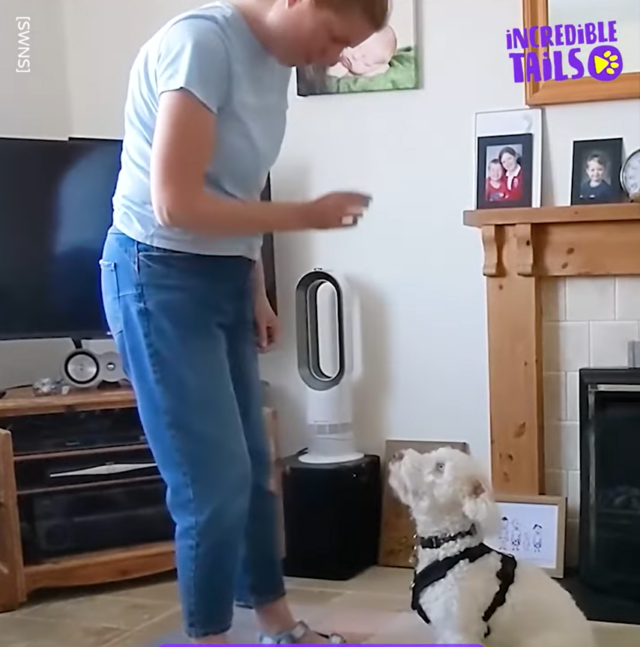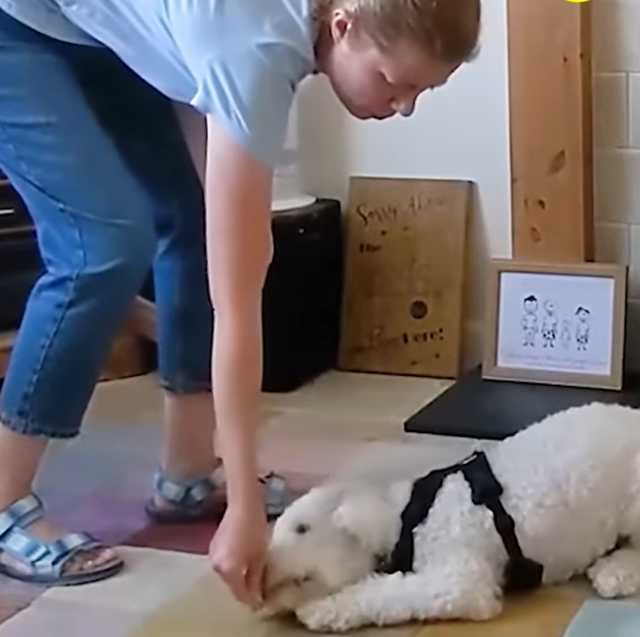Pre-school teacher Jo Le Page and her family welcomed a Spanish Water Dog puppy named Rafa this past June but soon realized there was something different about him. The fluffy white pup didn’t respond to loud noises, even the shrill sound of the smoke alarm.
While the rest of the family wanted to return Rafa and look for a new puppy, Jo had other plans. She googled sign language for dogs, and “it opened up a whole new world.”

Rafa is now seven months old, and Jo has taught him nine sign language commands, including “sit,” “stand,” “watch me,” “spin,” “give paw,” “lie down,” “come,” “stay” and “safe,” which involves him walking under Jo’s legs, turning around, and awaiting further instruction. The clever pup mastered all of this in just eight weeks!
Rehomed Deaf Pit Bull Is Certain She’s Going Back To The Shelter Once Again
A Differently-Abled Dog
The Le Page family, who live on the British island of Guernsey, discovered their new puppy was deaf within a day of bringing him home.
“He wasn’t responding to any noise and he wouldn’t wake up when we came in,” Jo said. “He didn’t respond to loud drilling noise or the smoke alarm going off.”

Despite his hearing disability, Rafa had already learned to rely on his other senses. Jo noticed that he studied his surroundings closely, picking up on visual cues in the absence of auditory ones.
“Rafa would turn his head when other puppies heard noises and would follow all of them,” she said. “He was always good at following cues of other puppies.”
Being a white dog, Rafa was likely born deaf. As the AKC explains,
“Cochleosaccular is the most common cause of deafness and is associated with coat color patterns. It is usually seen in dogs with the piebald color gene or merle color gene. It can cause deafness in either one or both ears and is seen more in association with blue eyes and a white coat. This type of deafness can be first seen between 1 to 3 weeks of age.”

An Important Lesson
While deaf dogs can be more difficult to train, Jo was up for the challenge.
“Our initial thoughts were that it would be hard or impossible to train a dog who can’t hear,” she said. “We thought it would definitely be impossible to drop his lead on a walk. Education and training has proved that all of our fears were false.”
Rafa proved to be an exceptional student. He was eager to learn and highly responsive to toys and treats for a job well done.
“The training is all done with hand signals. Thumbs up are used for praise,” Jo explained. “You can’t use hands in a negative way, so showing something to be unacceptable is difficult.”

The pup’s incredible progress in just eight weeks proves that deaf dogs can do anything hearing dogs can, albeit differently. Jo says the experience “has been a big education for the whole family.”
“This is only the beginning of his journey and we just take it a day at a time,” she said.
Watch Rafa and Jo in action!
https://www.youtube.com/watch?v=KKiYYLsJbG4
 Toledo, United States.
Toledo, United States.